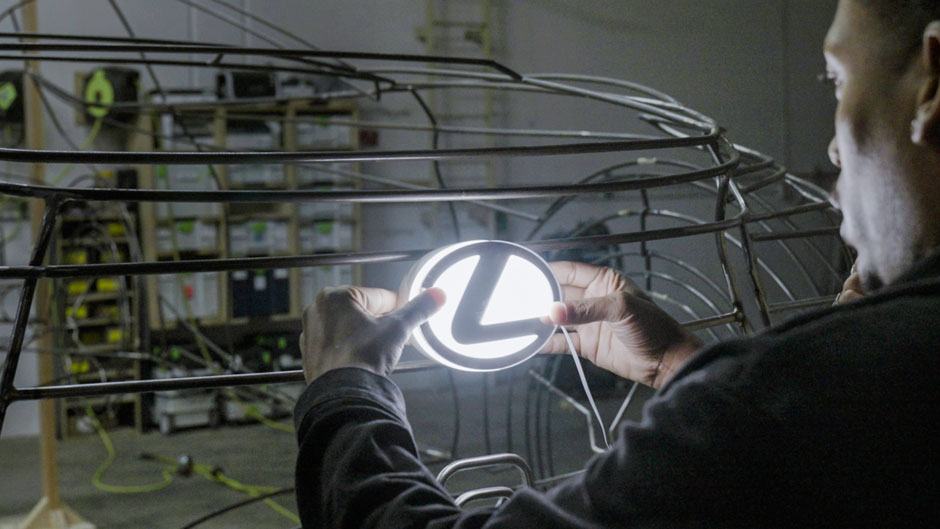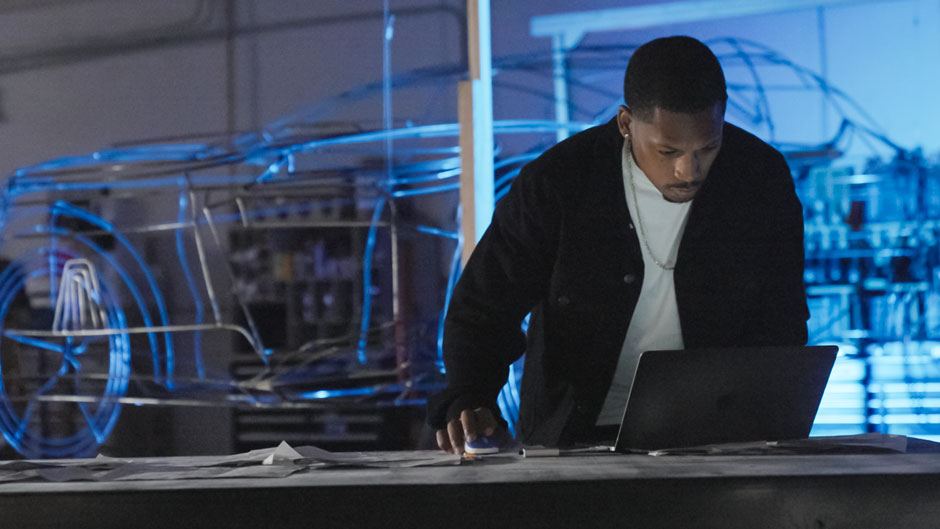With the finishing touches to architect Germane Barnes’ newest creation already in place, all that awaits is the big reveal. That will come on Dec. 1, when his work will be displayed at Design Miami/ on Miami Beach.
In many respects, the location couldn’t be more fitting. The coastal city has been dubbed ground zero for sea level rise. And the installation created by Barnes, an assistant professor in the University of Miami’s School of Architecture, offers a solution to the cause of rising seas: reducing the amount of greenhouse gases in the atmosphere via zero-emission transportation options.
His work is a full-scale, 3/8-inch-thick wireframe sculpture of Lexus’ LF-Z zero-emission electric concept car. He created the exhibit for the luxury automobile brand to showcase its vision of an “electrified” and “carbon-neutral” future.
Synchronized LEDs and spotlights will illuminate the car as guests stroll past it in Pride Park opposite the Miami Beach Convention Center.
“We were also inspired to show the global reach of technology,” said Barnes, a winner of the 2021 Architectural League Prize for Young Architects and Designers and a 2021-22 Rome Prize Fellow at the American Academy in Rome.

“Because of the way COVID has forced artists and others to present their work virtually or to be a part of their work virtually, we knew we could take advantage of that,” he explained. “So, there are some digital components within the installation that are tied to social media platforms that allow individuals who can’t physically be in Miami Beach to still be a part of the exhibit and still have a role in its execution. And we feel that’s in line with Lexus’ core design principle of human-centered design.”
When Lexus, one of the sponsors for the upcoming international design fair, approached Barnes and his private design studio with the idea of creating the installation, he immediately jumped at the opportunity, making the decision to involve his students in the design process and to rely on the resources of a high-tech School of Architecture lab.
Working within his Community Housing and Identity Lab (CHIL), Barnes’ students played a critical role in the project, designing the furniture elements that complement the installation and assisting in some of the technical components. “It’s been rewarding to see their designs become reality,” Barnes said. “They’re pretty excited that what they’ve come up with will actually be part of the installation.”
The furniture—which, in an obvious nod to Lexus’ philosophy of being carbon neutral, is made of wood, not plastic—helps accomplish the exhibit’s goal of also serving as a social-gathering spot, Barnes said. “A space where people can sit, relax, maybe charge their cellphones, just take a break from the busyness of the fair, while at the same time learning about the electrified future that Lexus envisions.”
For the installation’s high-tech, interactive features, Barnes turned to the school’s Responsive Architecture and Design (RAD) Lab, which specializes in smart technologies and ubiquitous computing.
Indrit Alushani, a research associate in the RAD lab, said the lab team was very excited to help Barnes integrate the social aspect into the technology of the installation. “We wanted the work to extend outside of the physical bounds of Miami and have a global outreach,” Alushani said. “So, we researched ways on integrating RGB [red, green, blue] LED lights to respond to requests from people around the globe. We found solutions through surfboards, Arduinos, and various application plug-ins to change RGB colors as requested by those interested in participating on this interactive piece. The installation will display wash lights on white walls as the backdrop of the wireframe-hanging car.”
To make the wireframe sculpture itself, Barnes turned to Portland, Oregon-based fabricators Matchless, which worked on a tight time schedule to complete it.
Barnes is honored to have led a multifaceted design team on the project. “It’s a great platform to showcase the talent in South Florida and a great opportunity to showcase the talent at the University of Miami,” he said “The students working on this are extremely gifted. For their talent to be displayed to the world on this platform is huge.
“It also affords me an opportunity to follow the legacy of many other talented designers who were tapped to do this in the past for Lexus,” Barnes continued. “It means a lot to be acknowledged as a designer on the rise.”
Then, there’s what Barnes refers to as the “cool” aspect of working on the exhibit.
“When I was a kid growing up in Chicago, my mother would always tell me her dream car was a Lexus,” he said. “And in hip hop culture, Lexus is a prominent brand. Considering that’s what I was born into, this project sort of defines my upbringing. So, it’s pretty cool to be able to live the thing that you watched on music videos growing up.”

